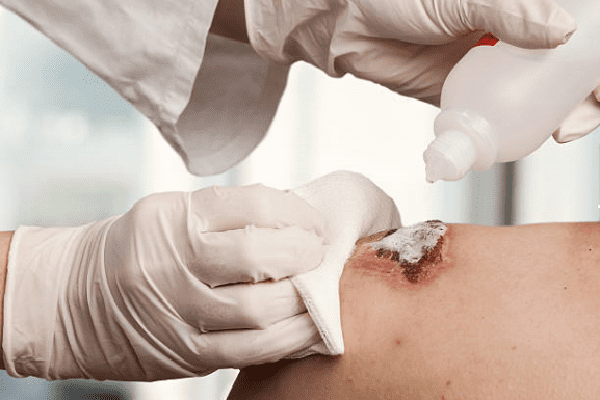Enzymes >>>> Proteolytic enzymes as bio-antiseptics
Proteolytic enzymes as bio-antiseptics.

Currently, medical science pays close attention to certain properties of enzymes, which make it possible to use them not only in the treatment of diseases of the digestive system, but also as biological antiseptics, which are not inferior in effectiveness to other biological antiseptics. Of particular interest in this area are proteolytic enzymes (proteases), which have the ability to break peptide (protein) bonds and thereby break down elements of protein origin, which is of great importance in the regulation of reparative processes.
At the beginning of the last century, it was noticed that proteolysis (the process of decomposition of protein structures with the participation of enzymes - proteases) has a beneficial effect on the foci of inflammation, on the rate of wound healing, on the aggregation properties of blood, and also has a local immunostimulating effect. Under the action of enzymes, the scarring of tissues passes gently, and the scars are more elastic. By themselves, proteolytic enzymes (proteases) do not have the ability to kill or stop the reproduction of pathogenic microorganisms, but they are endowed with the ability to melt (lyse) necrotic tissue, pus, fibrin, and are able to enhance the effectiveness of antibacterial drugs. The action of enzymes - proteases is based on their property to dissolve necrotic tissue without damaging healthy tissue, to break down proteins in the wound and deprive pathogenic microorganisms of their usual nutrient medium.
The properties of proteolytic enzymes are quite diverse, they have the following abilities:
- Provide fibrinolytic and necrolytic action,
- They work as decongestants and anti-inflammatories,
- Have an immunomodulatory effect,
- Regulate regenerative processes,
- Improves blood microcirculation.
Since thrombus formation is based on the participation of a protein - fibrin (fibrinogen), the participation of proteases in the process of cleavage of fibrin will prevent the formation of thrombi in cases where it is necessary to improve vascular patency, and at the same time will reduce the aggregation ability of platelets, will work as an anticoagulant, improve microcirculation of blood.
Proteases are capable of lysing necrotic plaque and fibrinous formations under local influence, liquefy viscous secretions and exudates, thereby accelerating the processes of tissue regeneration. This ability of enzymes - proteases makes it possible not to carry out repeated surgical interventions, but, like a scalpel, cleans the regeneration sites from necrotic plaque.
The area of application of proteolytic enzymes as bio-antiseptics:
- In surgery: purulent wounds, burns, bedsores, frostbite, trophic ulcers, abscesses, a href="en_paper.php?ids=230&word=purulent_infection">panaritiums, phlegmon, furunculosis, thrombophlebitis.
- In ophthalmology: iridocyclitis, keratitis (including herpetic), iritis, corneal burns, clouding of the lens of inflammatory origin, cataracts, bleeding in the eye, retinitis, optic nerve atrophy, retinal degeneration, endophthalmitis, uveitis, conjunctivitis, chronic.
- In otolaryngology: sinusitis and other sinusitis, otitis media, tonsillitis, pharyngitis.
- In pulmonology: purulent bronchitis, pleural empyema, bronchiectasis, exudative pleurisy.
- In dentistry: aphthous stomatitis, postoperative purulent complications, inflammatory - dystrophic forms of periodontitis, complicated alveolitis, periostitis.
Technique of using proteolytic enzymes in practice.
Proteases are applied topically after treatment of the focus with solutions of furacilin, hydrogen peroxide or other external antiseptics, moistening a napkin in an enzyme solution and applying it to the treatment site. In some cases (with abundant purulent discharge), the enzyme powder is poured into the wound area. Some enzymes are produced in the form of ointments (Asperaza, Iruksol) for applications, which facilitates the mechanism of their use.
In the treatment of tonsillitis, pharyngitis, purulent sore throat, aphthous stomatitis and other diseases of the oral cavity and pharynx, enzymes in the form of a solution are used for rinsing, irrigating and manually treating the sites of necrotic plaque.
With otitis media, sinusitis, it is possible to introduce enzymes into the cavity using special syringes and catheters.
With intracavitary purulent inflammation, enzymes are injected into the cavity using catheters, a drainage system, and puncture.
In ophthalmology, enzymes are injected into the required area of the eye using electrophoresis, instillation.
If it is necessary to use enzymes for purulent diseases of the respiratory system, inhalations are carried out with solutions of enzymes or they are injected into the region of the bronchi, lungs using catheters or bronchoscopes.
Sometimes, as anti-inflammatory drugs, proteolytic enzymes are administered intravenously or intramuscularly.
Main enzymes used as bio-antiseptics
Chymotrypsin, trypsin - enzymes of animal origin (obtained from animal tissues to create medicines). Chymotrypsin and trypsin have the ability to enhance the effect of antibiotics. Therefore, their use is effective in combination with antibiotic therapy, since it reduces the duration of antibiotic use and the duration of the disease. The drug Himopsin contains chymotrypsin and trypsin.
Terrilitin, collalisin, streptokinase, asperase are enzymes of fungal and bacterial origin. Streptokinase analogs are streptodecase and urokinase. Streptokinase, streptodecase, urokinase are activators of fibrinolysis. Collalysin (collagenase, clostridiopeptidase A) causes destruction of connective tissue and keloid scars, promotes soft scarring of tissue.
Proteolytic enzymes have contraindications in some cases, and some of them (streptokinase, urokinase, fibrinolysin) require a combination with anticoagulants, since they accelerate blood clotting. Trypsin, chymotrypsin, asperase cause bleeding and can cause fever, Urokinase can cause bronchospasm. Many protease enzymes cause allergic reactions. Therefore, before using any of the preparations containing the aforementioned proteolytic enzymes, it is necessary to carefully study the instructions for their use, especially in the section on tolerance, adverse reactions and contraindications.

Read

Read



























